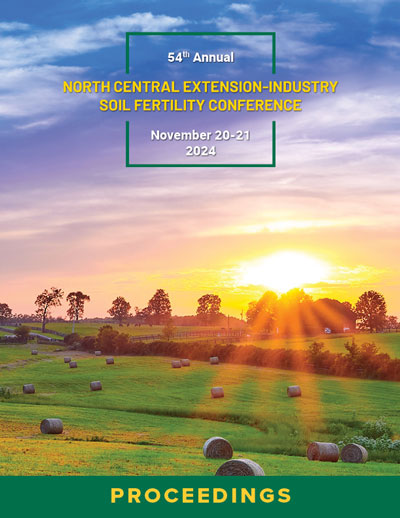Download the
Conference Proceedings
Proceedings
Authors
| Filter results9 paper(s) found. |
|---|
1. Application of the Ceres-maize Model to Maximum Yield ResearchMaximum yields are obtained when as much assimilate as possible is partitioned into the grains of corn. The amount partitioned into the grains depends on several major factors. Grains per unit area is probably the most important of these factors. Other important considerations for grain filling in- clude the duration of the grain filling period, the amount that can be repartitioned from stem storage to the grains, the photo- synthesis rate, and the temperature. Several factors influence the number... |
2. Establishing (and Differentiating) On-farm Research and Demonstration TrialsAs the 1990s begin, funding agencies are looking beyond the traditional definition of who does "research." While university, USDA and private industry have traditionally conducted research in the past, grassroot organizations, local agency personnel and individual farmers are now proposing and implementing research of various types. An overall trend seems to be for research experiments to be evaluated on farmersf fields. Some of this movement may be a political statement against traditional methods... |
3. The Effect of Tillage and Lime Rate on Soil Acidity and Grain Yields of a Corn-Soybean RotationModern tillage systems, such as reduced tillage and no-tillage systems, provide shallow incorporation of surface applied materials at best. Because of concern of over-liming the surface few inches of agricultural soils, producers either reduce lime rates (and apply more often) or perform some sort of soil inversion to mix the lime deeper into the soil profile. The objectives ofthis field study were to evaluate the effects of tillage, lime rate and time of limestone application on corn and soybean... |
4. Varying Nitrogen and Seeding Rates of Corn Across Productivity Regions in FieldsA field study was conducted fiom 1999 to 2001 to determine the effects of variable seeding rates and variable nitrogen rates on corn (Zeu muys L.) in southern Ihois. In whole field experiments, variable seeding rates ranging fiom 18,000 to 38,000 seeds ac-' in 4.000 seed increments were planted in randomized strips (in a randomized complete block design) across the field that had soils with varying productivity based upon historical yield maps. From the yield data it was determined that the optimum... |
5. Using Historical Yield Patterns in Fields as a Management Tool to Variably Apply NitrgenIn whole field studies in southem Illinois a uniform rate of N application was compared with variably applied rates of N based upon historical crop yields for each field. The fields used were partitioned in "low". "medium", and "high" zones of productivity depending upon the normalized yield of the preceding 5 to 10 years of crops grown. Two formulas were used to variably apply nitrogen. One formula (VRN-One) calculated a N rate that favored more fertilizer in "high" productivity regions and less... |
6. Periodic Deep Tillage of No-till Corn and Soybean Systems in Southern IllinoisLow organic matter and low available moisture supplying soils in southern Illinois lend themselves to no-tillage crop production, but concern about compaction and rooting depth have led some to employ the use of periodic tillage. A field study was conducted at two locations in southern Illinois between 2000 and 2006 to evaluate the effects of periodic deep tillage (ripping 16-18 inches [40-45 cm] with minimum surface disturbance style shanks) prior to corn or soybean production. Deep tillage occurring... |
7. Soil pH and Manganese Effects on Roundup Ready SoybeansSoybean 'flas'h is a general yellowing of th e upper soybean canopy thought to be associated with high rates of glyphosate and reduced levels of manganese (Mn) with glyphosate-resistant soybeans. Several field sites varying in soil Mn levels and some with within field variable pH levels were evaluated between 2004 and 2006 for re sponsiveness of soybeans to glyphosate rate and Mn treatments. The objectives of this study were to 1) evaluate the effects of foliar applied Mn and soil applied Mn on yiel... |
8. Nitrogen Availability of Treated and Raw Dairy ManureThere is minimal information on the nitrogen (N) availability and composition of treated manures. Knowing how N availability differs w ith manure treatment will result in better N crediting guidelines. Raw dairy manure and anaer obically digested manure were incubated with five typical Wisconsin soils for 112 d. Net N mineralized from the different N sources were compared. Nitrogen mineralizatio n differed by manure type and also by soil. Overall, the digested slurry and the digested separated liquid... |
9. Nitrate-N Loss Reduction: Scale of In-Field and Edge-of-Field Practice Implementation to Reach Water Quality GoalsStates in the Mississippi River Basin have developed state level nutrient reduction strategies in response to the 2008 Hypoxia Action Plan. The Iowa Nutrient Reduction Strategy was released in 2013 and the Nonpoint Source Nutrient Reduction Strategy Science Assessment reviews potential practice performance in reducing downstream nutrient loss and the scale of implementation that would be necessary to reach the Hypoxia Action Plan goal of a 45% reduction in riverine Nitrogen and Phosphorus. To... M. Helmers |
